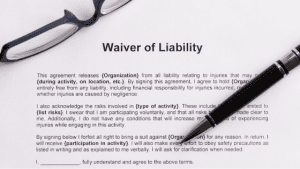Have you found yourself being asked to sign a liability waiver before participating in an activity by a company/venue hosting? Or you are ready to leave on a trip, but before you board the bus, your signature is required? Finally, your child is on a field trip heading to the zoo across state lines and before he can go, you must sign a waiver for your minor absolving responsibility for any injuries that might occur during the trip.
These are common experiences. In today’s adventure-travel-entertainment driven society, people regularly agree to sign legal documents in order to participate in anything from cruise ship excursions, skiing, bungee
jumping, helicopter rides, amusement parks, bus tours, extreme sports and other high-risk experiences such as NASCAR races. These liability waivers are written to absolve the host company of any responsibility for injuries or accidents that might occur. However, the waivers are many times not as concrete as they seem.
The goal is that one party (the customer or client) agrees to “waive,” or give up the right to pursue legal action for injuries that occur on the property regardless of whose fault it is. This is why it is very important to read these documents before hastily signing. Even when you do, understand that not all liability waivers are held up in court.
Here are 5 things to know about what you are signing:
- The language in the waiver must be clear or unambiguous about the circumstances in which the organization is not responsible. This is required since the law treats contracts which are negotiated between parties, where they both have input, differently from ones where one party simply presents the agreement to the other side and tells them they have to sign it. If the language is deemed unclear, ambiguous or has loopholes, the injured party might be able to sue.
- The location of the language that absolves the party of responsibility must be prominently seen. If it is tucked away within a lengthy document or difficult to find (small print), the court can determine you did not give away your right to sue. On the other hand, if the important language is found early in the document and in bold lettering, the document will be more easily enforced.
- The reason for an injury might not be waivable. Most well written waivers intend to protect the organization from acts of negligence or ordinary carelessness; on the other hand, intentional actions, gross negligence or acts that by law result in strict liability are not waived. In addition, if an organization makes you sign a waiver and then does not provide expected standard of care, then the waiver can be rejected by the court.
- The state in which the waiver is written and enforced matters. Some states are stricter about enforcement, while others are more lenient, depending on the current laws. Georgia is considered a more lenient state, while Florida is more moderate in terms of enforcement. For example, when parents sign a waiver in one state for a minor to travel and participate in activities in another state, the enforcement of the liability waiver can vary depending on where the injury occurs.
- The strength of the waiver is important, because not all liability waivers are created equal. Companies with limited resources may use an easy-to-find waiver on the internet, while another company may hire an experienced legal team to design a waiver based on specifics of the potential risk involved.
Remember, your signature on a liability waiver does not necessarily mean you have signed your rights away after injury has occurred. Each case is different. By turning to experienced injury lawyers such as Friedman & Martin for help, you might be due compensation for medical expenses, pain, loss of work and other damages. Call us for a free consultation today.

